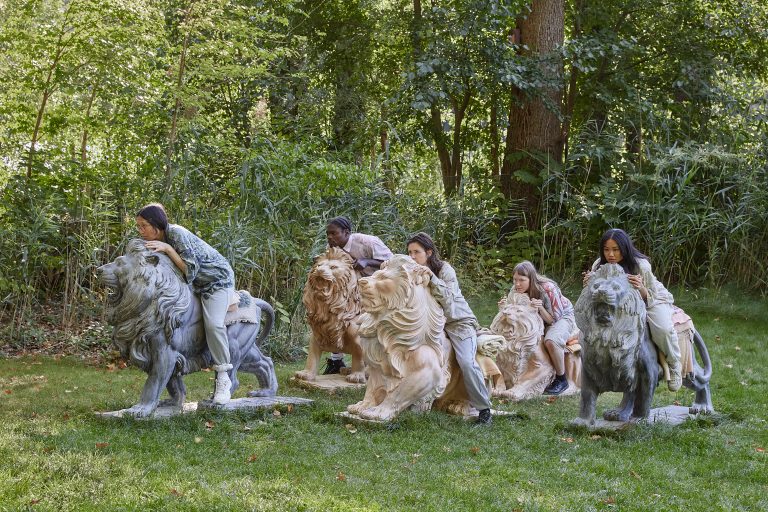
Bob Kil & Nina Beier
All Fours, 2024
Performance in the Sculpture Park at Haus am Waldsee, photo: Sandy Volz
Haus am Waldsee‘s 10.000 square meter park is a sculpture park in permanent transition. Here, we debate the contemporary concept of sculpture by means of selected works.
Bob Kil & Nina Beier
All Fours, 2024
Performance in the Sculpture Park at Haus am Waldsee, photo: Sandy Volz
Peter Wächtler (*1979)
Orso, 2019, bronze
Peter Wächtler (*1979)
Lupo, 2019, bronze
Barkow Leibinger (*1957) and (*1963)
Summer House II, 2016/20
Reinterpretation of a summer pavilion commissioned by the Serpentine Gallery in Kensigton Gardens, London.
Karl Hartung (1908-1967)
Flügelsäule, 1960/61
Wing forms were a major theme of Karl Hartung by the 1930s. Since 1935 he developed works between figuration and biomorphic abstraction in Henry Moore‘s sense of the term. A year later Hartung moved to Berlin. After military service and wartime imprisonment – in 1943 he was able to visit Picasso – he was appointed to the reopened Hochschule für Bildende Künste in Berlin. From 1959 to 1964 he serves as deputy director of that art academy. He participates in all the major international art exhibitions such as documenta, Venice biennial, Sao Paulo and the Brussels World‘s Fair. Key concerns in his understanding of a figure striving for levity are defying gravity, organic forms of growth analogous to nature and transitions from the inner to the outer.
Photo: Bernd Borchardt
Francis Zeischegg (*1956)
Jagdschutzholzstapel zur Beobachtung von Wilderern, 2002
In 2011 the artist found the “Jagdschutzholzstapel” in a forestry magazine in Potsdam. This hut camouflaged as a wood pile was used in the GDR for detecting poachers. Reconstruction of a GDR “Forstschutzeinrichtung” (forest protection facility), round wood, pine, oiled duplex boards, stainless steel connections.
Photo: Bernd Borchardt
Daniel Pflumm (*1968)
Lichtobjekt o.T., 2006-09
Like a large Esso sign with its characteristic blue trim, this light object by Daniel Pflumm illuminates the outer edge of the front garden and alerts passing people and cars to the exhibition space. Pflumm works with the signs of advertising without using their brand names. The empty signpost turns into a sign of advertising as such. The viewer may ask himself how much he takes for granted when he completes, without thinking, the corresponding lettering. Well-known on an international stage through numerous exhibitions, Pflumm took part in the group show Anstoss Berlin at Haus am Waldsee in 2006.
Susanne Rottenbacher (*1968)
Sturm und Drang, 2006-09
The light sculpture was created on commission for the entrance gate of the newly renovated Haus am Waldsee in 2019. Colourful LED-tubes circle concentratively around a centre from which dynamics are guided into the space.
Initially, Rottenbacher, who was born in 1969 in Göttingen, studied stage design at the Columbia University in New York. She then continued her studies with a focus in light design at the Bartlett School of Architecture and Planning in London. After several commissions as a stage and light designer, Rottenbacher turned towards working in the liberal art scene in 2004.
Photo: Claus Rottenbacher

Bob Kil & Nina Beier
All Fours, 2024
Performance in the Sculpture Park at Haus am Waldsee, photo: Sandy Volz
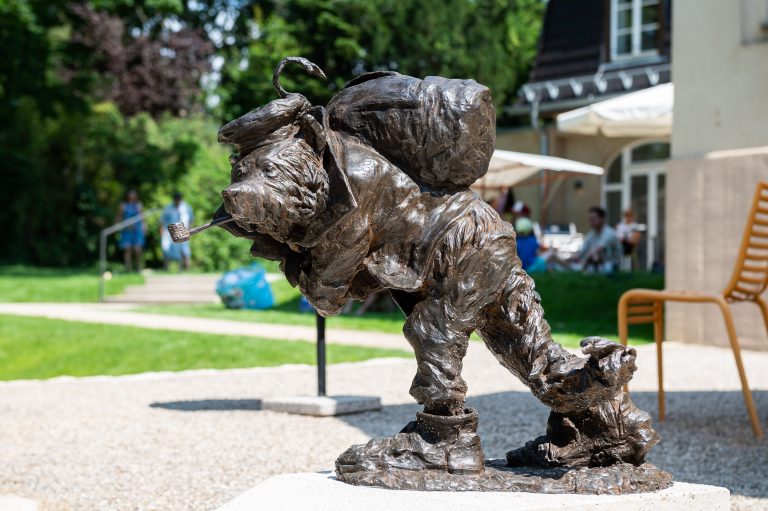
Peter Wächtler (*1979)
Lupo, 2019, bronze

Karl Hartung (1908-1967)
Flügelsäule, 1960/61
Wing forms were a major theme of Karl Hartung by the 1930s. Since 1935 he developed works between figuration and biomorphic abstraction in Henry Moore‘s sense of the term. A year later Hartung moved to Berlin. After military service and wartime imprisonment – in 1943 he was able to visit Picasso – he was appointed to the reopened Hochschule für Bildende Künste in Berlin. From 1959 to 1964 he serves as deputy director of that art academy. He participates in all the major international art exhibitions such as documenta, Venice biennial, Sao Paulo and the Brussels World‘s Fair. Key concerns in his understanding of a figure striving for levity are defying gravity, organic forms of growth analogous to nature and transitions from the inner to the outer.
Photo: Bernd Borchardt
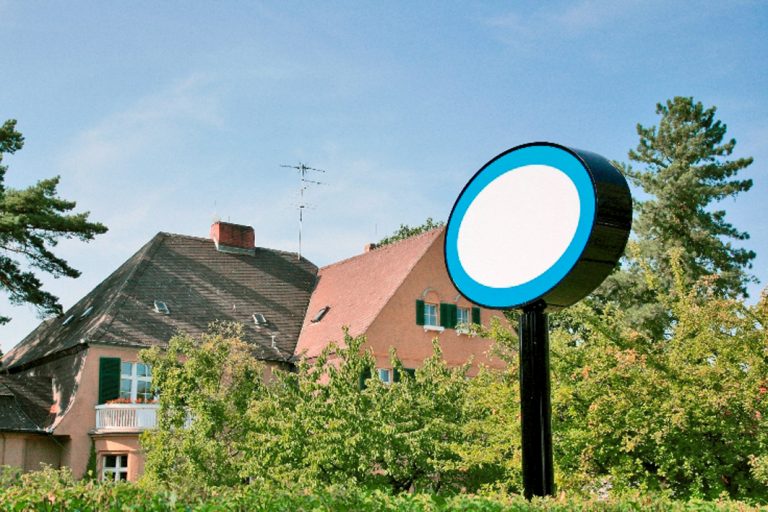
Daniel Pflumm (*1968)
Lichtobjekt o.T., 2006-09
Like a large Esso sign with its characteristic blue trim, this light object by Daniel Pflumm illuminates the outer edge of the front garden and alerts passing people and cars to the exhibition space. Pflumm works with the signs of advertising without using their brand names. The empty signpost turns into a sign of advertising as such. The viewer may ask himself how much he takes for granted when he completes, without thinking, the corresponding lettering. Well-known on an international stage through numerous exhibitions, Pflumm took part in the group show Anstoss Berlin at Haus am Waldsee in 2006.

Peter Wächtler (*1979)
Orso, 2019, bronze

Barkow Leibinger (*1957) and (*1963)
Summer House II, 2016/20
Reinterpretation of a summer pavilion commissioned by the Serpentine Gallery in Kensigton Gardens, London.

Francis Zeischegg (*1956)
Jagdschutzholzstapel zur Beobachtung von Wilderern, 2002
In 2011 the artist found the “Jagdschutzholzstapel” in a forestry magazine in Potsdam. This hut camouflaged as a wood pile was used in the GDR for detecting poachers. Reconstruction of a GDR “Forstschutzeinrichtung” (forest protection facility), round wood, pine, oiled duplex boards, stainless steel connections.
Photo: Bernd Borchardt

Susanne Rottenbacher (*1968)
Sturm und Drang, 2006-09
The light sculpture was created on commission for the entrance gate of the newly renovated Haus am Waldsee in 2019. Colourful LED-tubes circle concentratively around a centre from which dynamics are guided into the space.
Initially, Rottenbacher, who was born in 1969 in Göttingen, studied stage design at the Columbia University in New York. She then continued her studies with a focus in light design at the Bartlett School of Architecture and Planning in London. After several commissions as a stage and light designer, Rottenbacher turned towards working in the liberal art scene in 2004.
Photo: Claus Rottenbacher
Tony Cragg (*1949)
Versus, 2011/19, bronze, orange lacquer, 160 x 150 cm
Tony Cragg (*1949) is one of the world’s leading contemporary sculptors. For the reopening of Haus am Waldsee, the artist loaned us the sculpture Versus (2011) in March 2019. After Outspan (2008), this is now the second generous loan from the artist, which, at the request of the artistic director, acts as the signet of the sculpture park.
The British artist has lived and worked in Wuppertal since 1977, where he spent two years in complete seclusion after studying painting in London. While studying at the Royal College of Art in London, he discovered the medium of sculpture for himself. The encounter with the conceptual artist Richard Long may have influenced him.
In the 1980s, Cragg was successful on the international art market and was represented at documenta 7, 1982 and documenta 8, 1987, as well as at the Biennales in Venice, Sidney and São Paulo. Cragg taught at the Art Academy in Dusseldorf from 1979 and at the University of the Arts in Berlin from 2002. From 2009 – 2013 he was rector of the Dusseldorf Art Academy.
The first version of the sculpture Versus, which the artist is loaning to Haus am Waldsee, was created in 2011 from orange lacquered laminated wood. It was presented under the pyramid of the Louvre in Paris in the context of a solo exhibition. In the following years, bronzes were created in various sizes based on the motif. Among them, the version created in 2019 for Haus am Waldsee is the second largest sculpture and the only one in signal red. Versus belongs to the group of works by Rational Beings, in which Cragg revisits the motif of the stack as he has pursued it since his Stacked Objects since 1976. Here, material such as ice or hot metal seems to melt under its own weight and through external temperature influences. Matter becomes energy, energy becomes matter.
Haus am Waldsee is preparing an extensive exhibition of his drawings with the artist for 2021. Tony Cragg has been running the private sculpture park Waldfrieden in Wuppertal since 2008. Next to the listed villa and former residence of the paint manufacturer Kurt Herberts, he has built two exhibition halls on the 15-hectare forest property, where solo exhibitions with international colleagues such as Eduardo Chillida, Mario Merz, John Chamberlain, and younger sculptors are regularly held.
Photo: Bernd Borchardt
Katja Strunz (*1970)
Kreatur des Einfalls, 2019, coated steel
The sculpture revolves around the moment of time in the sense of memory and trauma. The sculptor-philosopher takes language as her starting point: the form, tapering downwards, shoots into the earth like an arrow. The viewer becomes witness to an “idea”, the moment that can suddenly change everything, the creative thought that is nourished by both the past and the future. Katja Strunz’ work stands for the ambivalence between the disintegration of tradition and memory and the saving thought that makes the new suddenly tangible.
Photo: Roman März
Angela Bulloch (*1966)
Heavy Metal Stack of Six: Greige, 2017, Powder-coated steel, Height: 3 meters
The stele belongs to a series of sculptures which have been created on the theme of geometric, variable shapes in vertical sequences since 2014. Using computer programmes, convex polyhedra of different shapes are designed and stacked. Through the use of light and dark colours – in this case off-white, light grey and aubergine brown – three-dimensional fields are created that seem to reach into the surrounding area, appear flat or withdrawn. Depending on one’s point of view, this optical illusion appears dynamic or clearly rhythmic. Each rhombus has an individual shape but is closely related to the others in the stacked row.
Photo: Roman März
Thomas Rentmeister (*1964)
Depot, gestern, 2009
For a number of years, Thomas Rentmeister has built sculptures from stacked refrigerators. He brings together everyday articles directly serving our personal hygiene or indirectly furthering our bodily comfort. Rather than filling the surfaces and spaces between the objects with Penaten baby crème, as he did in earlier works, the artist exposes the refrigerating volumes, in an analogy to human ageing, to the processes of decay and thus he dares us to question our aesthetic sensibilities. Rentmeister had a solo exhibition at Haus am Waldsee in 2007.
Photo: Bernd Borchardt
Jo Schöpfer (*1951)
Sfera, 2001, aluminium, diameter 140 cm
Schöpfer’s abstract sculpture, made from aluminium ribbons, forms a spherical netting which circles an empty core and alludes to traces of moving celestial bodies.
Jo Schöpfer studied sculpture from 1974-1980 at Staatliche Akademie der Künstler in Stuttgart. He was a lecturer at the faculty of architecture at the University of Karlsruhe from 1985-1990.
Photo: Paul Schöpfer, VG Bild-Kunst Bonn 2019
Markus Jeschaunig (*1982)
The Weather Project, 2018, fog installation on the Waldsee
Markus Jeschaunig works at the interface between science and art. For the construction site party, he realised The Weather Project on the Waldsee. The installation in the water creates a climatic phenomenon on the lake.
Photo: Markus Jeschaunig
Peter Ablinger (*1959)
Weiss / Weisslich 30, 2008, reed, wind
The sound installation by the Austrian composer Peter Ablinger stands in direct contact to the natural sounds of its surroundings. Thus, the difference between the rustle of leaf trees and that of rushes constitutes the actual subject-matter. In 2008, Peter Ablinger had a solo exhibition at Haus am Waldsee which was entitled Hören hören (listening to listening).
Lynn Chadwick (1914-2003)
Beast Alerted I, 1990, stainless steel
Photo: Roman März
At the end of the 1980s, the British sculptor Lynn Chadwick resumed working on depictions of animals as they had been created in bronze since the late 1950s and exhibited in the Haus am Waldsee in 1960.
Beast Alerted I was created in 1990 simultaneously in bronze and stainless steel. The version of stainless steel, which was shown here at Haus am Waldsee, exemplifies the artistic focus on figurative construction and clear surfaces. From all angles applicable, this formal language is a reminder of Chadwick’s early education as an architect. Beast Alerted I belongs to a series of five “wild” animals, that were set up between 1989/90 at the spacious residency of the artist in Gloucester, in the west of London. They communicate directly with their surroundings and yet appear like alien objects.
Hans Uhlmann (1900–1975)
Entfaltung, 1966, chrome-nickel steel, black tinted
Loan from Bau- und Liegenschaftsbetrieb NRW
The chrome-nickel-steel sculpture Entfaltung (Unfolding) by Hans Uhlmann (Berlin, 1900 – 1975) was created in 1966 for the Bielefeld State School of Engineering and represents Uhlmann’s fifteenth commissioned work. As part of the exhibition Lynn Chadwick, Katja Strunz, Hans Uhlmann, in which we devoted ourselves in detail to the subject of folding in 20th and 21st century sculpture in the summer of 2019, the work travelled to the Waldsee on loan. There it can be seen until July 2020. So take the opportunity to have a look at this wonderful work and compare it with other sculptures by the sculptor in Berlin – especially with the sculpture in front of Deutsche Oper.
Hans Uhlmann was a trained engineer. It was not until the 1930s that he began private art studies in addition to his work as a lecturer at the Berlin Technical University. He created his first sculptures made of iron wire, which he exhibited in the Gurlitt Gallery. After the Second World War, Uhlmann gave up his bread and butter profession very soon. Without an artistic-academic education, he decided to dedicate his life to sculpture. Within a few years he developed into the leading steel sculptor in Germany. In the mid-1950s, Uhlmann accepted a professorship at the Berlin University of the Arts. Not only in Berlin was he soon one of the most sought-after German artists of the post-war period, winning numerous competitions for art in public spaces during the reconstruction and being invited to major international exhibitions.
Uhlmann’s first works after the Second World War were semi-abstract, lyrical creations, each created from a single wire that “drew” the body contours of birds and insects into the room. In keeping with the specifications of Antoine Pevsner and Naum Gabo, who called for a modern sculpture without body volume in the Realist Manifesto 1922/23, these works were transparent and reduced to a minimum of volume.
As a mathematically and technically oriented person, from the early 1950s onwards Uhlmann developed sculptures made of cut steel plates, which he placed in close dialogue with space as if they were folded out of paper. From 1962 onwards, this also included works like Entfaltung.
In contrast to the early wire sculptures, Uhlmann here thinks from the core of a form and unfolds it outwards. Above a diagonally directed support leg, our Entfaltung develops like a blossoming bud towards the light. The work was created for the exterior space of a university. This is where young people enter and leave who can develop, unfold and grow through education. Uhlmann always found such metaphors in his commissioned works that harmonized the use of the buildings with the formal vocabulary of his impressive works.
Read more about the sculptural works of Hans Uhlmann in public space in Berlin.
Here you can purchase the catalogue Beasts of the Times – Lynn Chadwick, Katja Strunz, Hans Uhlmann.
Photo: Roman März
Olav Christopher Jenssen (*1954)
Lingaphone, 2008, PVC, lacquer
These slabs, slice sculptures derived from folded and cut out pieces of paper can be read as frames, projection screens and blank spaces. Olav Christopher Jenssen is a painter. He works on the boundaries between consciousness and intuition. In 2008, he had a solo exhibition at Haus am Waldsee.
Photo: Bernd Borchardt
Erik Steinbrecher (*1963)
ALPAMARE, 2010/12, aluminium casting
The Swiss conceptual artist Erik Steinbrecher has created a hybrid stone sculpture in four parts. It resembles a group of small trees with trunks and crowns. The trunks are made of bamboo reed. Bread crowns represent a kind of plant or fruit. The artist considers slices of toast to be material; white bread as food from the conveyor belt but also as material for “posh” nibbles such as Croque Monsieur, Sandwiches etc. Toast is also the last bread you can buy at petrol stations at night. The work reflects on our relationship to body and soul.
Photo: Bernd Borchardt
Tony Cragg (*1949)
Outspan, 2008, bronze
Photo: Berndt Borchardt
Werner Aisslinger (*1964)
Loftcube, 2003
Photo: Bernd Borchardt
Werner Aisslinger realised his vision of living for the first time four years ago – in the sky above Berlin. During the DESIGNMAI BERLIN 2003, the first design-festival in the German capital, the innovative prototype of these mobile loft-containers premiered. The internationally renowned designer asked himself: “How could a temporary, minimalistic housing unit look like, that allows for a private refuge under the nomadic living conditions in the dense urban spaces of today?”Instead of theoretical excursion, he put his realisation up for discussion.
The space is spectacular: in close proximity to the Waldsee and therefore not like the first draft on a cold-storage depot at the banks of the Spree river. Where the earlier “Loftcubes” exemplified the possibilities of contemporary urban living, here, the cube has arrived in nature. Since many people work far away from any traces of nature, their living conditions could improve tremendously through this “Art Cube” as a meditative place of retreat. With the architectural framing of “flying constructions” (fliegende Bauten), which is used for temporary and non-site-specific architecture, the designer Werner Aisslinger also refers to the mobility of his living units. In its most expansive version, the transportation to the next place of residency happens via helicopter. But other means of transportation, like with a mobile crane, are possible, too. In addition to that, the modularly constructed casing can be dismantled and is therefore suitable for any environment, may it be a lonely mountainside, a flat roof in the city centre, the Waldsee or close to Potsdamer Platz.
Social Knit Work Berlin
2015, knitted carpet
Photo: Haus am Waldsee
The 20 meters long, red pixeled knitted carpet leading to the lake was inspired by the guerrilla-knitting-movement in the USA. On a regular basis since 2011, women from Friedenau and elsewhere meet at public spaces to knit together. The group from Berlin was part of the Triennale Bingen in 2014 (Haus mit Kaugummiautomat). Till the end of August 2015, the carpet was an invitation to the visitors to sit down, rest and daydream.
Simon Faithfull (*1966)
Shy Fountain, 2018
Photo: Bernd Borchardt
The fountain in the lake only exists when nobody is in immediate proximity. As soon as the viewer steps closer, the ephemeral artwork disappears. Only silence will bring it back into exitance. Simon Faithfull is a video and sketch artist and was part of the double exhibition Schwerelos (Weightless) in 2009 with Carla Guagliardi at Haus am Waldsee.
Michael Sailstorfer (*1979)
Wohnen mit Verkehrsanbindung (Großkatzbach), 2001
Photo: Haus am Waldsee
Bus stop, bed, kitchen, table, chair, shelve, toilet, door, light, electricity and water. Sailstorfer’s interest lays in the absurdity within our mobility optimised society. When five bus stops in his lower Bavarian hometown were up for replacement, he bought and worked on them. As a survival unit equipped with bed, chair, table, stove and privy, this shelter minimises the apparent space between living and being on the way.
Ina Weber (*1964)
Trümmerbahnen, 2004
Photo: Bernd Borchardt
The artist was trained in Kassel by Martin Kippenberger amongst others. Inherent to the subversive artistic strategy of Berlin based sculptor Ina Weber is her focus on the profane and trivial parts of the city scape, which mostly slip our conscious perception. From this thought process, she created a miniature golf course furnished with ruinous architectural sides as obstacles. In a jovial yet unmasking way, she displays her bewilderingly sized models. Ina Weber had a solo show (Hier) at Haus am Waldsee in 2013.
Katinka Pilscheur
9-2007-2, 2007, truck tarps
Photo: Bernd Borchardt
For her works, Katinka Pilscheur uses everyday materials and colour pallets, which are then recontextualised in a side-specific manner. In this case, two oversized pillow-objects made from truck tarpaulin were placed on top of each other in such a way that they appear “used”, as if after a night’s sleep. Here, the intimate becomes public.
Wilhelm Mundt (*1959)
Trashstone 412, 2006
Photo: Bernd Borchardt
Since the 90s, Milhelm Mundt wraps his studio waste in PVC foil and transforms it into tightly packed “stones” which get their form merely through the items they contain. Weighing tons, the so created stone number 412 seems like a time capsule bursting with energy. The artist is now teaching sculpture at the Kunstakademie Dresden.
William Engelen (*1964)
Meteophon, 2009
Photo: Bernd Borchardt
The sound piece in the construction trailer by Dutch artist William Engelen translates the current weather data into audible tones. By comparing the data sets with the meteorological average values of the last ten years, the discrepancies between those two create a symphony of frog quacking, cello tunes, chants and the sound of chewed apples.
Jeppe Hein (*1974)
Modified Social Bench #4, 2008
Photo: Bernd Borchardt
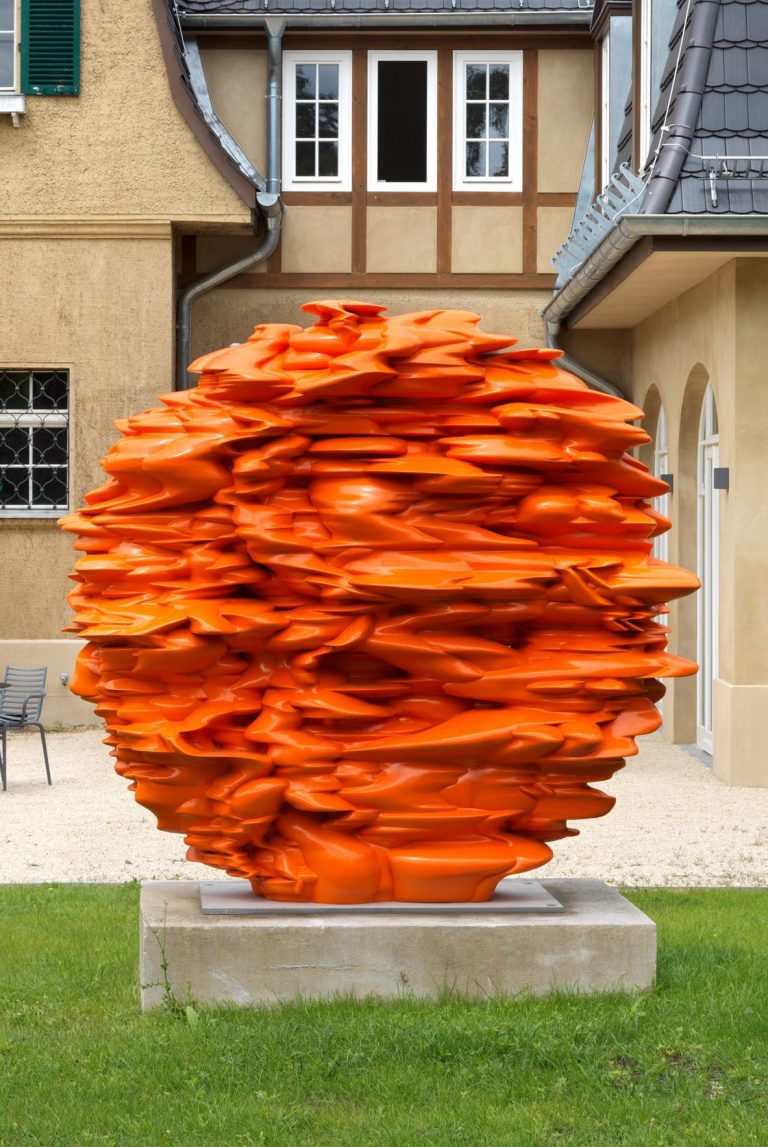
Tony Cragg (*1949)
Versus, 2011/19, bronze, orange lacquer, 160 x 150 cm
Tony Cragg (*1949) is one of the world’s leading contemporary sculptors. For the reopening of Haus am Waldsee, the artist loaned us the sculpture Versus (2011) in March 2019. After Outspan (2008), this is now the second generous loan from the artist, which, at the request of the artistic director, acts as the signet of the sculpture park.
The British artist has lived and worked in Wuppertal since 1977, where he spent two years in complete seclusion after studying painting in London. While studying at the Royal College of Art in London, he discovered the medium of sculpture for himself. The encounter with the conceptual artist Richard Long may have influenced him.
In the 1980s, Cragg was successful on the international art market and was represented at documenta 7, 1982 and documenta 8, 1987, as well as at the Biennales in Venice, Sidney and São Paulo. Cragg taught at the Art Academy in Dusseldorf from 1979 and at the University of the Arts in Berlin from 2002. From 2009 – 2013 he was rector of the Dusseldorf Art Academy.
The first version of the sculpture Versus, which the artist is loaning to Haus am Waldsee, was created in 2011 from orange lacquered laminated wood. It was presented under the pyramid of the Louvre in Paris in the context of a solo exhibition. In the following years, bronzes were created in various sizes based on the motif. Among them, the version created in 2019 for Haus am Waldsee is the second largest sculpture and the only one in signal red. Versus belongs to the group of works by Rational Beings, in which Cragg revisits the motif of the stack as he has pursued it since his Stacked Objects since 1976. Here, material such as ice or hot metal seems to melt under its own weight and through external temperature influences. Matter becomes energy, energy becomes matter.
Haus am Waldsee is preparing an extensive exhibition of his drawings with the artist for 2021. Tony Cragg has been running the private sculpture park Waldfrieden in Wuppertal since 2008. Next to the listed villa and former residence of the paint manufacturer Kurt Herberts, he has built two exhibition halls on the 15-hectare forest property, where solo exhibitions with international colleagues such as Eduardo Chillida, Mario Merz, John Chamberlain, and younger sculptors are regularly held.
Photo: Bernd Borchardt
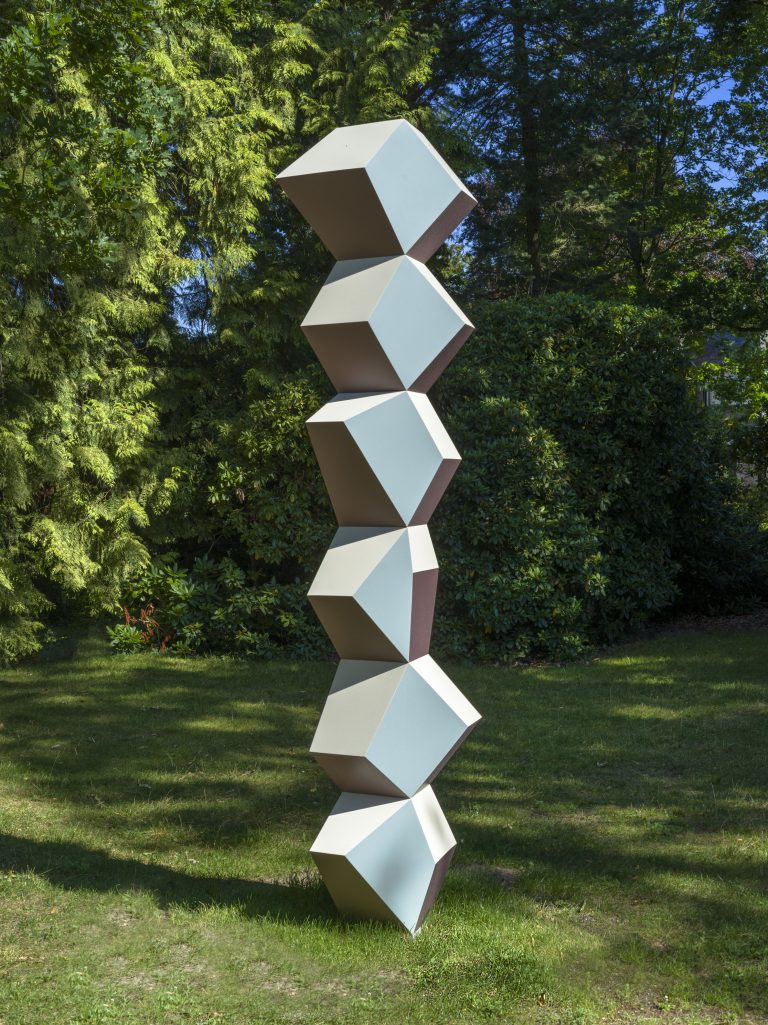
Angela Bulloch (*1966)
Heavy Metal Stack of Six: Greige, 2017, Powder-coated steel, Height: 3 meters
The stele belongs to a series of sculptures which have been created on the theme of geometric, variable shapes in vertical sequences since 2014. Using computer programmes, convex polyhedra of different shapes are designed and stacked. Through the use of light and dark colours – in this case off-white, light grey and aubergine brown – three-dimensional fields are created that seem to reach into the surrounding area, appear flat or withdrawn. Depending on one’s point of view, this optical illusion appears dynamic or clearly rhythmic. Each rhombus has an individual shape but is closely related to the others in the stacked row.
Photo: Roman März
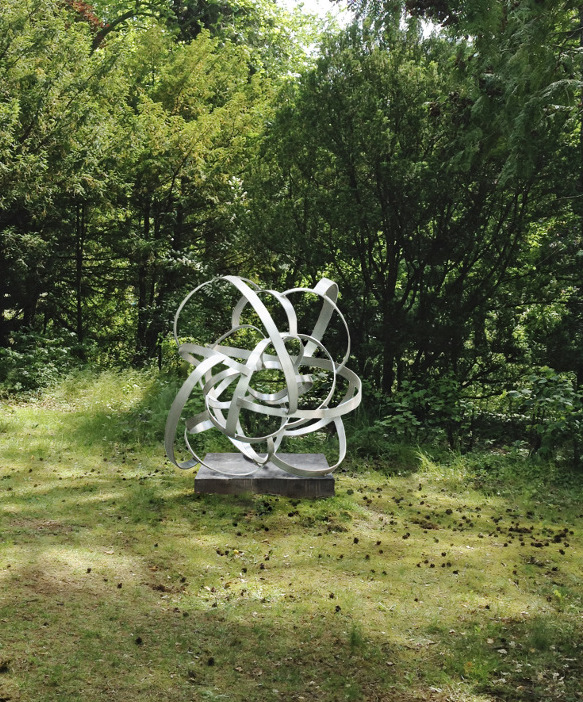
Jo Schöpfer (*1951)
Sfera, 2001, aluminium, diameter 140 cm
Schöpfer’s abstract sculpture, made from aluminium ribbons, forms a spherical netting which circles an empty core and alludes to traces of moving celestial bodies.
Jo Schöpfer studied sculpture from 1974-1980 at Staatliche Akademie der Künstler in Stuttgart. He was a lecturer at the faculty of architecture at the University of Karlsruhe from 1985-1990.
Photo: Paul Schöpfer, VG Bild-Kunst Bonn 2019
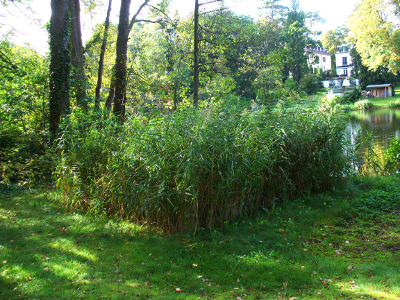
Peter Ablinger (*1959)
Weiss / Weisslich 30, 2008, reed, wind
The sound installation by the Austrian composer Peter Ablinger stands in direct contact to the natural sounds of its surroundings. Thus, the difference between the rustle of leaf trees and that of rushes constitutes the actual subject-matter. In 2008, Peter Ablinger had a solo exhibition at Haus am Waldsee which was entitled Hören hören (listening to listening).
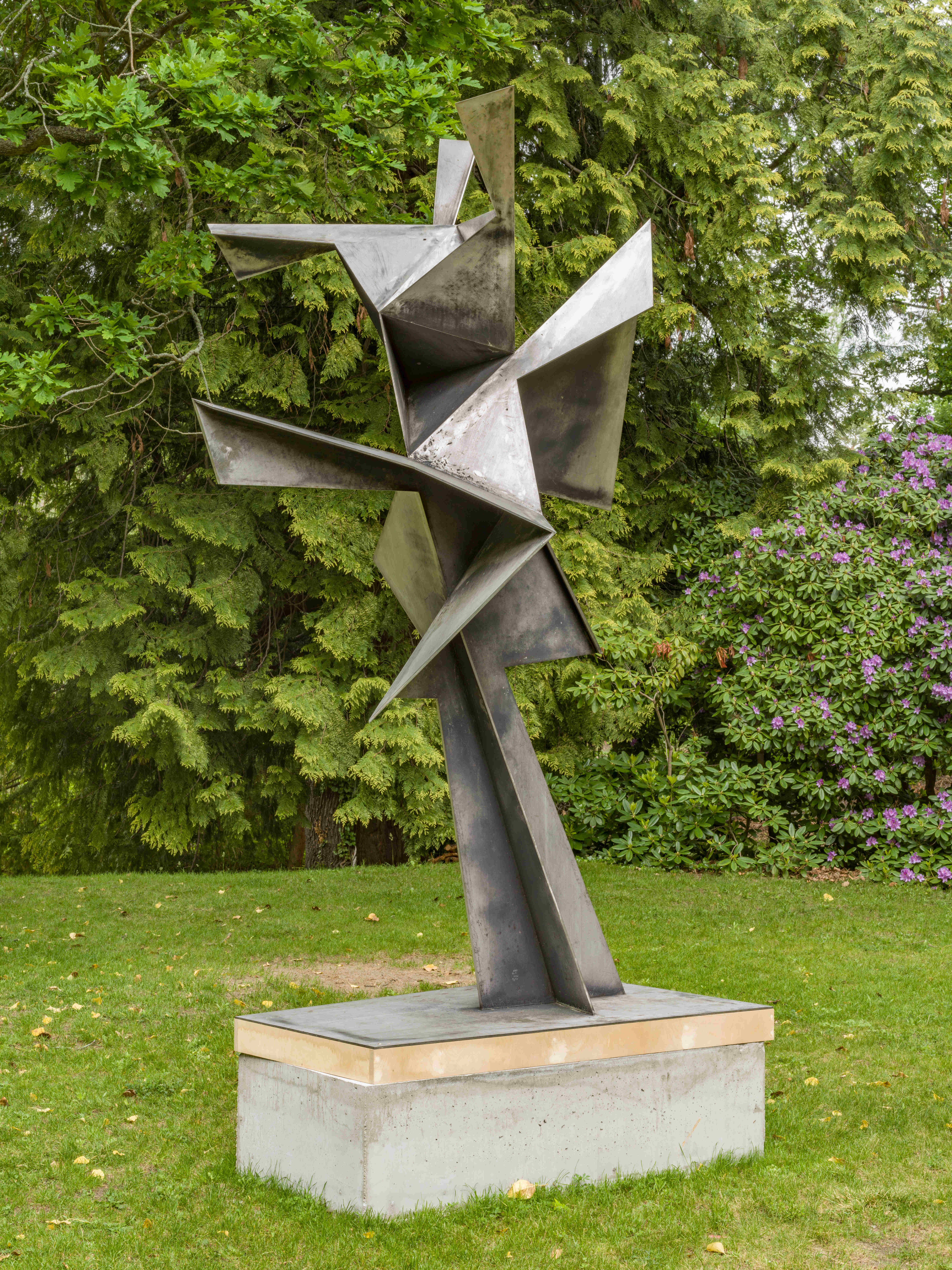
Hans Uhlmann (1900–1975)
Entfaltung, 1966, chrome-nickel steel, black tinted
Loan from Bau- und Liegenschaftsbetrieb NRW
The chrome-nickel-steel sculpture Entfaltung (Unfolding) by Hans Uhlmann (Berlin, 1900 – 1975) was created in 1966 for the Bielefeld State School of Engineering and represents Uhlmann’s fifteenth commissioned work. As part of the exhibition Lynn Chadwick, Katja Strunz, Hans Uhlmann, in which we devoted ourselves in detail to the subject of folding in 20th and 21st century sculpture in the summer of 2019, the work travelled to the Waldsee on loan. There it can be seen until July 2020. So take the opportunity to have a look at this wonderful work and compare it with other sculptures by the sculptor in Berlin – especially with the sculpture in front of Deutsche Oper.
Hans Uhlmann was a trained engineer. It was not until the 1930s that he began private art studies in addition to his work as a lecturer at the Berlin Technical University. He created his first sculptures made of iron wire, which he exhibited in the Gurlitt Gallery. After the Second World War, Uhlmann gave up his bread and butter profession very soon. Without an artistic-academic education, he decided to dedicate his life to sculpture. Within a few years he developed into the leading steel sculptor in Germany. In the mid-1950s, Uhlmann accepted a professorship at the Berlin University of the Arts. Not only in Berlin was he soon one of the most sought-after German artists of the post-war period, winning numerous competitions for art in public spaces during the reconstruction and being invited to major international exhibitions.
Uhlmann’s first works after the Second World War were semi-abstract, lyrical creations, each created from a single wire that “drew” the body contours of birds and insects into the room. In keeping with the specifications of Antoine Pevsner and Naum Gabo, who called for a modern sculpture without body volume in the Realist Manifesto 1922/23, these works were transparent and reduced to a minimum of volume.
As a mathematically and technically oriented person, from the early 1950s onwards Uhlmann developed sculptures made of cut steel plates, which he placed in close dialogue with space as if they were folded out of paper. From 1962 onwards, this also included works like Entfaltung.
In contrast to the early wire sculptures, Uhlmann here thinks from the core of a form and unfolds it outwards. Above a diagonally directed support leg, our Entfaltung develops like a blossoming bud towards the light. The work was created for the exterior space of a university. This is where young people enter and leave who can develop, unfold and grow through education. Uhlmann always found such metaphors in his commissioned works that harmonized the use of the buildings with the formal vocabulary of his impressive works.
Read more about the sculptural works of Hans Uhlmann in public space in Berlin.
Here you can purchase the catalogue Beasts of the Times – Lynn Chadwick, Katja Strunz, Hans Uhlmann.
Photo: Roman März
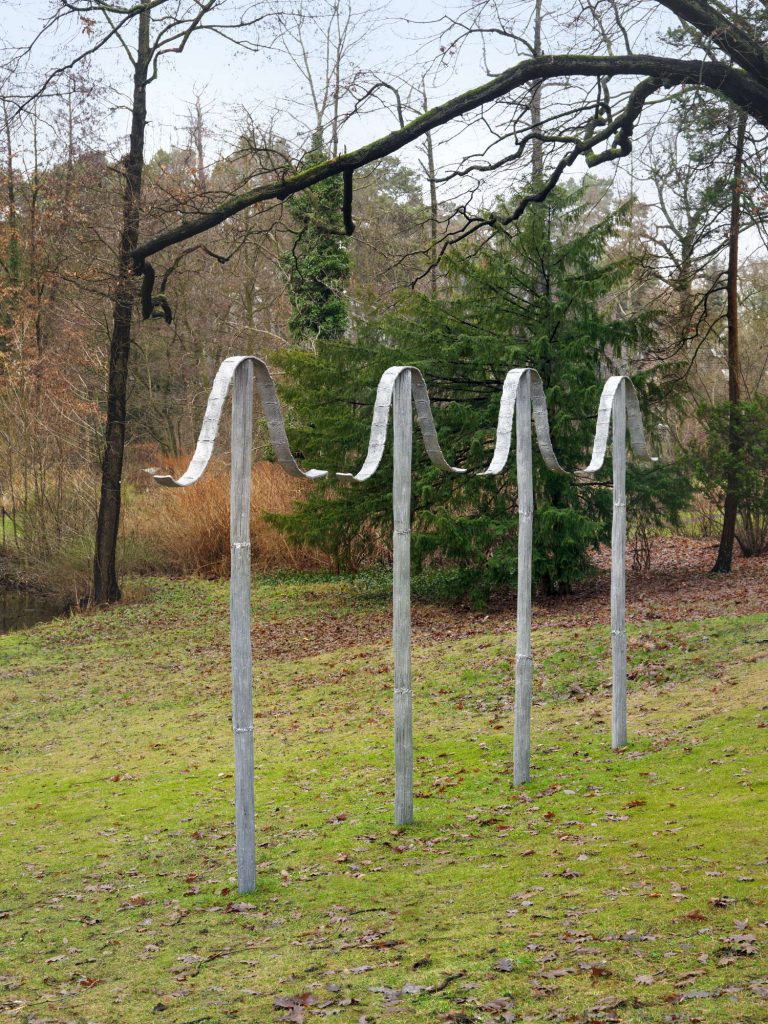
Erik Steinbrecher (*1963)
ALPAMARE, 2010/12, aluminium casting
The Swiss conceptual artist Erik Steinbrecher has created a hybrid stone sculpture in four parts. It resembles a group of small trees with trunks and crowns. The trunks are made of bamboo reed. Bread crowns represent a kind of plant or fruit. The artist considers slices of toast to be material; white bread as food from the conveyor belt but also as material for “posh” nibbles such as Croque Monsieur, Sandwiches etc. Toast is also the last bread you can buy at petrol stations at night. The work reflects on our relationship to body and soul.
Photo: Bernd Borchardt
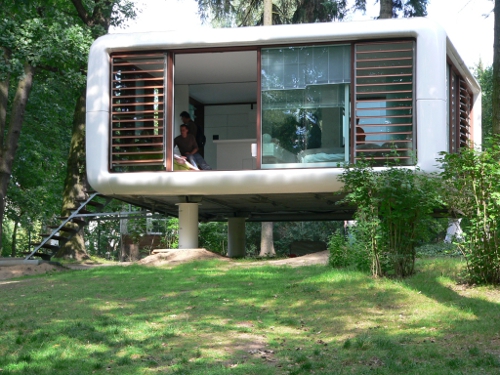
Werner Aisslinger (*1964)
Loftcube, 2003
Photo: Bernd Borchardt
Werner Aisslinger realised his vision of living for the first time four years ago – in the sky above Berlin. During the DESIGNMAI BERLIN 2003, the first design-festival in the German capital, the innovative prototype of these mobile loft-containers premiered. The internationally renowned designer asked himself: “How could a temporary, minimalistic housing unit look like, that allows for a private refuge under the nomadic living conditions in the dense urban spaces of today?”Instead of theoretical excursion, he put his realisation up for discussion.
The space is spectacular: in close proximity to the Waldsee and therefore not like the first draft on a cold-storage depot at the banks of the Spree river. Where the earlier “Loftcubes” exemplified the possibilities of contemporary urban living, here, the cube has arrived in nature. Since many people work far away from any traces of nature, their living conditions could improve tremendously through this “Art Cube” as a meditative place of retreat. With the architectural framing of “flying constructions” (fliegende Bauten), which is used for temporary and non-site-specific architecture, the designer Werner Aisslinger also refers to the mobility of his living units. In its most expansive version, the transportation to the next place of residency happens via helicopter. But other means of transportation, like with a mobile crane, are possible, too. In addition to that, the modularly constructed casing can be dismantled and is therefore suitable for any environment, may it be a lonely mountainside, a flat roof in the city centre, the Waldsee or close to Potsdamer Platz.
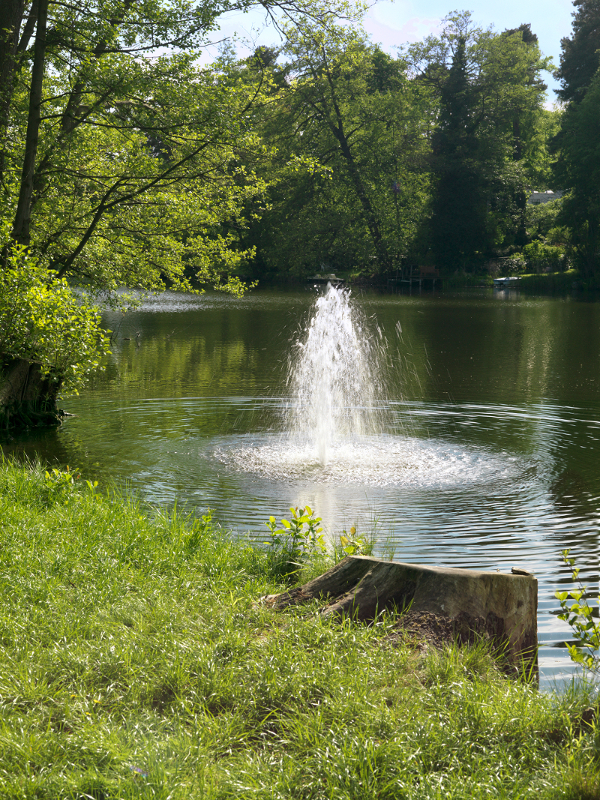
Simon Faithfull (*1966)
Shy Fountain, 2018
Photo: Bernd Borchardt
The fountain in the lake only exists when nobody is in immediate proximity. As soon as the viewer steps closer, the ephemeral artwork disappears. Only silence will bring it back into exitance. Simon Faithfull is a video and sketch artist and was part of the double exhibition Schwerelos (Weightless) in 2009 with Carla Guagliardi at Haus am Waldsee.
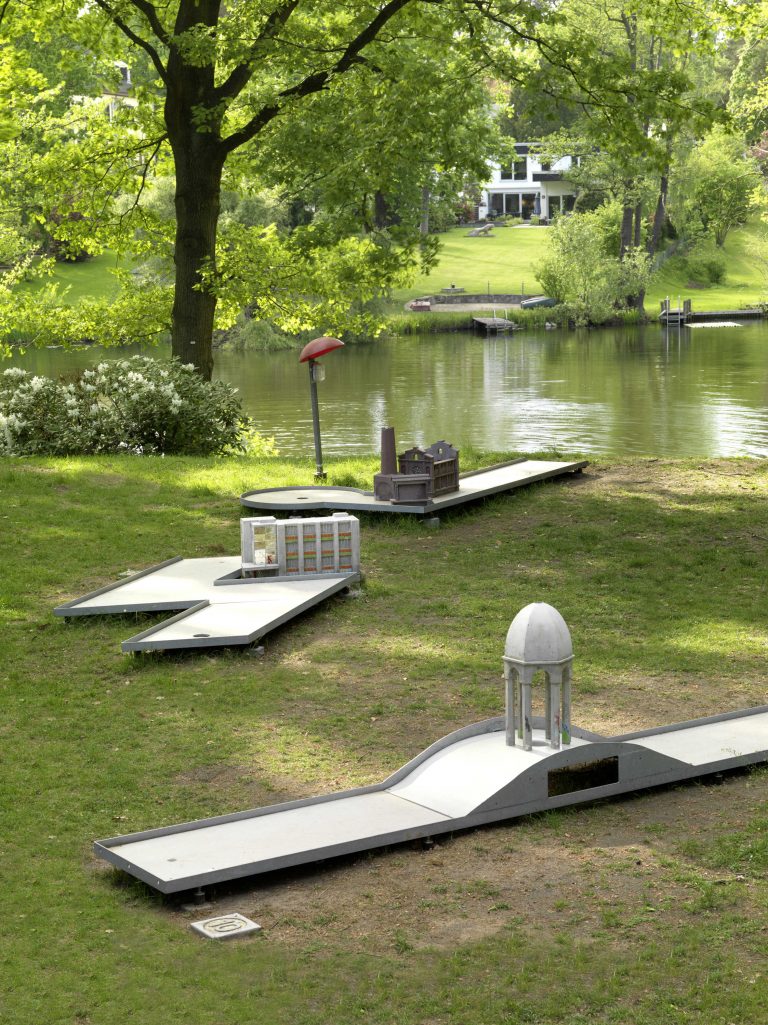
Ina Weber (*1964)
Trümmerbahnen, 2004
Photo: Bernd Borchardt
The artist was trained in Kassel by Martin Kippenberger amongst others. Inherent to the subversive artistic strategy of Berlin based sculptor Ina Weber is her focus on the profane and trivial parts of the city scape, which mostly slip our conscious perception. From this thought process, she created a miniature golf course furnished with ruinous architectural sides as obstacles. In a jovial yet unmasking way, she displays her bewilderingly sized models. Ina Weber had a solo show (Hier) at Haus am Waldsee in 2013.

Wilhelm Mundt (*1959)
Trashstone 412, 2006
Photo: Bernd Borchardt
Since the 90s, Milhelm Mundt wraps his studio waste in PVC foil and transforms it into tightly packed “stones” which get their form merely through the items they contain. Weighing tons, the so created stone number 412 seems like a time capsule bursting with energy. The artist is now teaching sculpture at the Kunstakademie Dresden.

Jeppe Hein (*1974)
Modified Social Bench #4, 2008
Photo: Bernd Borchardt
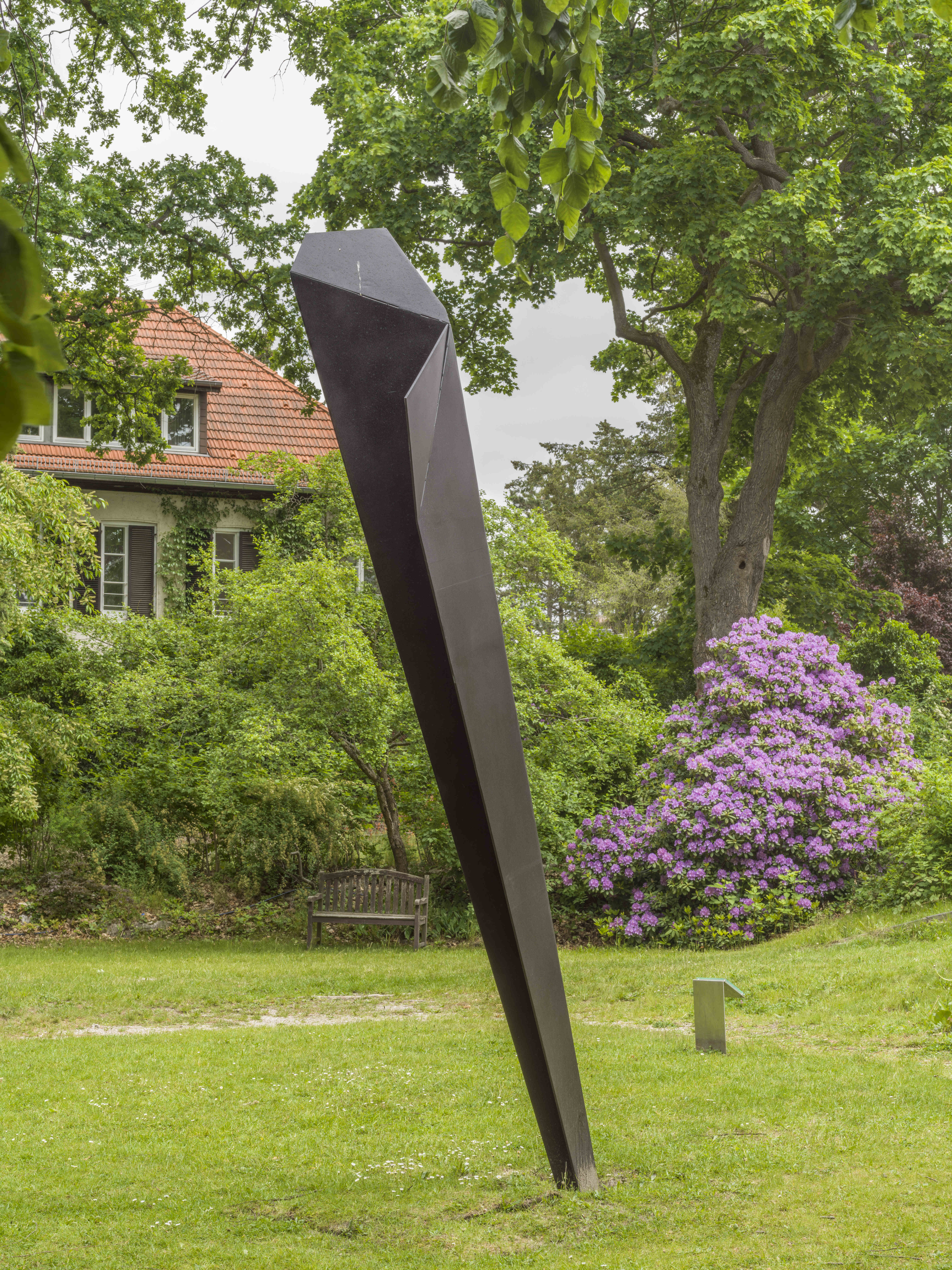
Katja Strunz (*1970)
Kreatur des Einfalls, 2019, coated steel
The sculpture revolves around the moment of time in the sense of memory and trauma. The sculptor-philosopher takes language as her starting point: the form, tapering downwards, shoots into the earth like an arrow. The viewer becomes witness to an “idea”, the moment that can suddenly change everything, the creative thought that is nourished by both the past and the future. Katja Strunz’ work stands for the ambivalence between the disintegration of tradition and memory and the saving thought that makes the new suddenly tangible.
Photo: Roman März
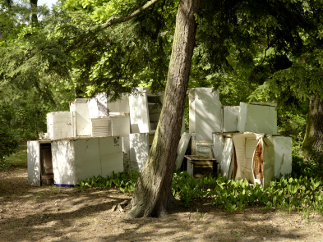
Thomas Rentmeister (*1964)
Depot, gestern, 2009
For a number of years, Thomas Rentmeister has built sculptures from stacked refrigerators. He brings together everyday articles directly serving our personal hygiene or indirectly furthering our bodily comfort. Rather than filling the surfaces and spaces between the objects with Penaten baby crème, as he did in earlier works, the artist exposes the refrigerating volumes, in an analogy to human ageing, to the processes of decay and thus he dares us to question our aesthetic sensibilities. Rentmeister had a solo exhibition at Haus am Waldsee in 2007.
Photo: Bernd Borchardt

Markus Jeschaunig (*1982)
The Weather Project, 2018, fog installation on the Waldsee
Markus Jeschaunig works at the interface between science and art. For the construction site party, he realised The Weather Project on the Waldsee. The installation in the water creates a climatic phenomenon on the lake.
Photo: Markus Jeschaunig
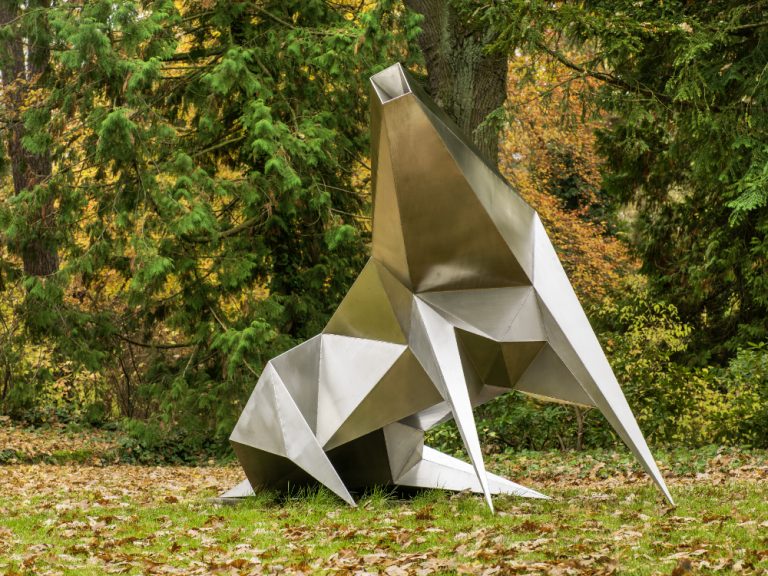
Lynn Chadwick (1914-2003)
Beast Alerted I, 1990, stainless steel
Photo: Roman März
At the end of the 1980s, the British sculptor Lynn Chadwick resumed working on depictions of animals as they had been created in bronze since the late 1950s and exhibited in the Haus am Waldsee in 1960.
Beast Alerted I was created in 1990 simultaneously in bronze and stainless steel. The version of stainless steel, which was shown here at Haus am Waldsee, exemplifies the artistic focus on figurative construction and clear surfaces. From all angles applicable, this formal language is a reminder of Chadwick’s early education as an architect. Beast Alerted I belongs to a series of five “wild” animals, that were set up between 1989/90 at the spacious residency of the artist in Gloucester, in the west of London. They communicate directly with their surroundings and yet appear like alien objects.
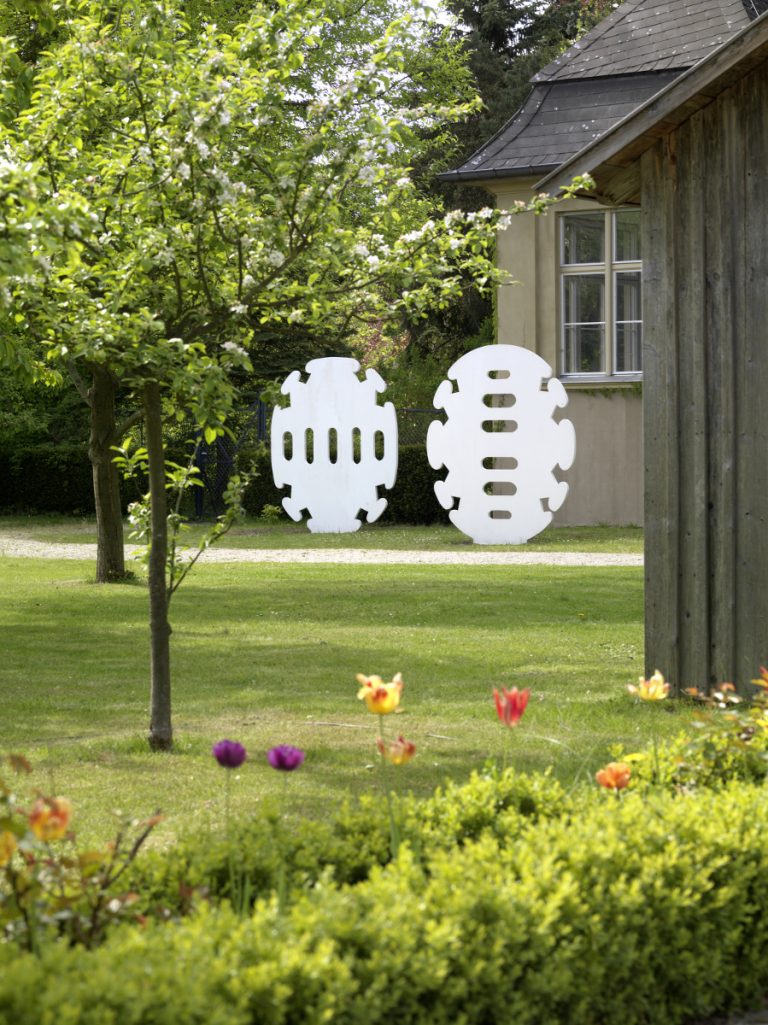
Olav Christopher Jenssen (*1954)
Lingaphone, 2008, PVC, lacquer
These slabs, slice sculptures derived from folded and cut out pieces of paper can be read as frames, projection screens and blank spaces. Olav Christopher Jenssen is a painter. He works on the boundaries between consciousness and intuition. In 2008, he had a solo exhibition at Haus am Waldsee.
Photo: Bernd Borchardt
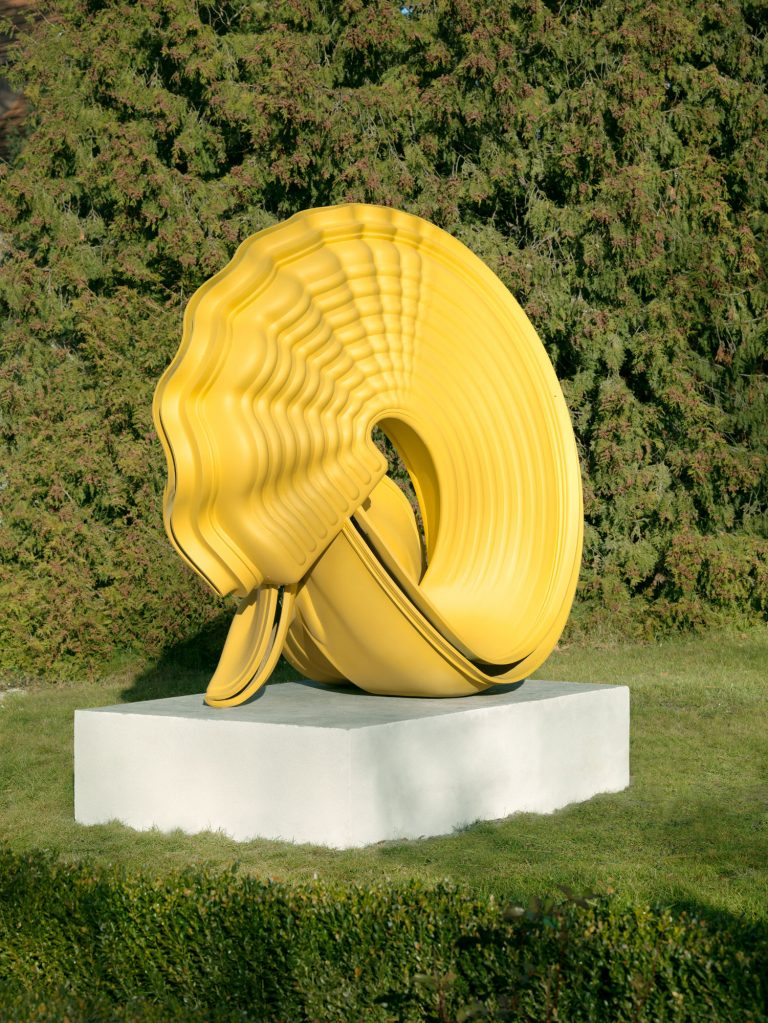
Tony Cragg (*1949)
Outspan, 2008, bronze
Photo: Berndt Borchardt

Social Knit Work Berlin
2015, knitted carpet
Photo: Haus am Waldsee
The 20 meters long, red pixeled knitted carpet leading to the lake was inspired by the guerrilla-knitting-movement in the USA. On a regular basis since 2011, women from Friedenau and elsewhere meet at public spaces to knit together. The group from Berlin was part of the Triennale Bingen in 2014 (Haus mit Kaugummiautomat). Till the end of August 2015, the carpet was an invitation to the visitors to sit down, rest and daydream.
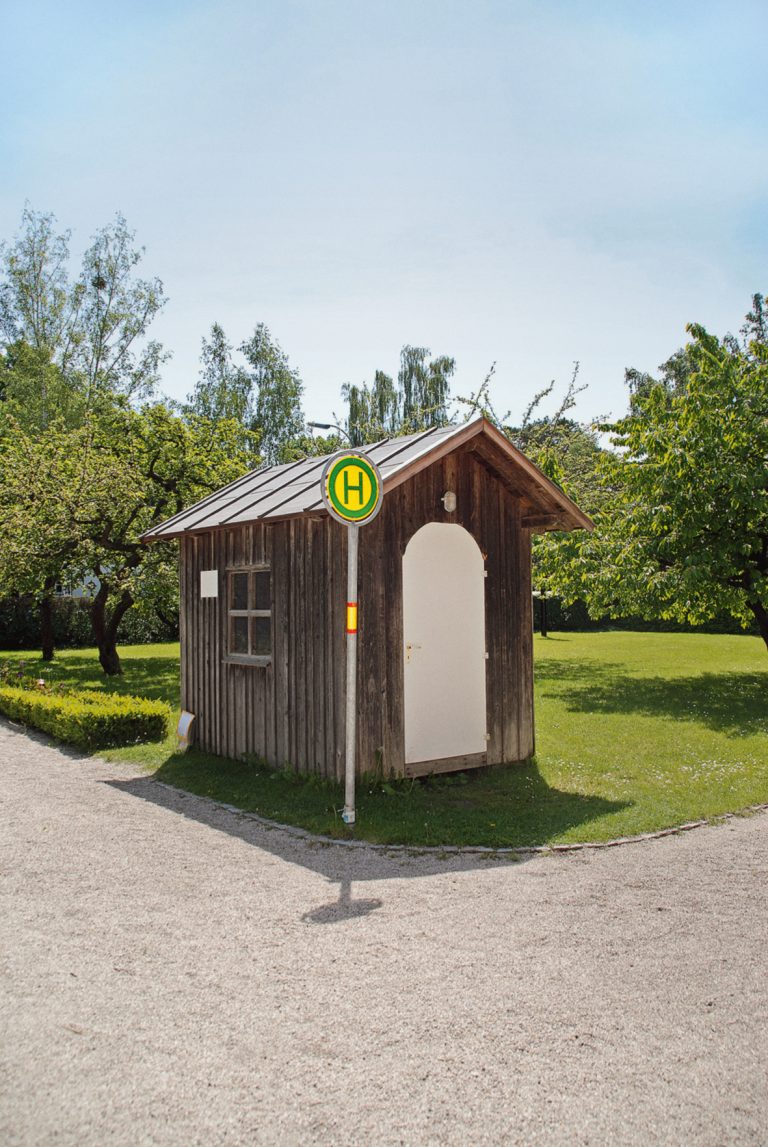
Michael Sailstorfer (*1979)
Wohnen mit Verkehrsanbindung (Großkatzbach), 2001
Photo: Haus am Waldsee
Bus stop, bed, kitchen, table, chair, shelve, toilet, door, light, electricity and water. Sailstorfer’s interest lays in the absurdity within our mobility optimised society. When five bus stops in his lower Bavarian hometown were up for replacement, he bought and worked on them. As a survival unit equipped with bed, chair, table, stove and privy, this shelter minimises the apparent space between living and being on the way.
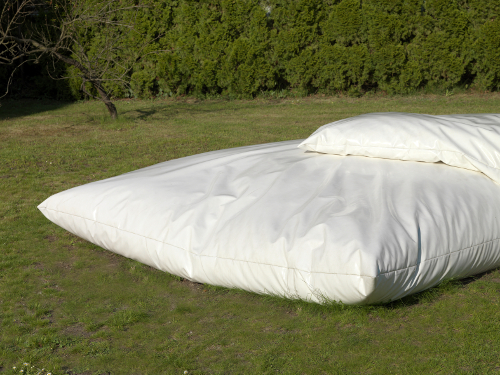
Katinka Pilscheur
9-2007-2, 2007, truck tarps
Photo: Bernd Borchardt
For her works, Katinka Pilscheur uses everyday materials and colour pallets, which are then recontextualised in a side-specific manner. In this case, two oversized pillow-objects made from truck tarpaulin were placed on top of each other in such a way that they appear “used”, as if after a night’s sleep. Here, the intimate becomes public.

William Engelen (*1964)
Meteophon, 2009
Photo: Bernd Borchardt
The sound piece in the construction trailer by Dutch artist William Engelen translates the current weather data into audible tones. By comparing the data sets with the meteorological average values of the last ten years, the discrepancies between those two create a symphony of frog quacking, cello tunes, chants and the sound of chewed apples.